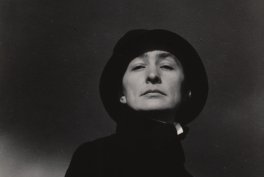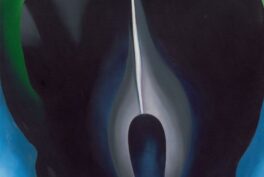O’Keeffe in New York
In 1924, Georgia O’Keeffe and her husband, Alfred Stieglitz, moved to the Shelton Hotel in New York, which at the time was the tallest residential skyscraper in the world. The building was designed by Arthur Loomis Harmon, who was also the architect of the Empire State Building. It is located in Midtown, now a district overflowing with high-rise buildings. However, this was not the case in the 1920s.
When O’Keeffe moved in, it was the highest building around, meaning she had an incredible view of the rapidly developing city. The show’s curators, Sarah Kelly Oehler and Annelise Madsen, successfully make the viewers realize how special O’Keeffe’s situation was. At the beginning of the exhibition, we are introduced to the context of the creation of the paintings. Unsurprisingly, the artist wanted to paint the city since it was within the hand’s reach.
A Woman Painting the City?
What is more, the skyscraper became a symbol of the progress and modern society of the United States, as Wanda M. Corn explained at the talk organized on the occasion of the exhibition. It was considered a gift to the world from the US. As one can imagine, the developing city and its upright buildings were associated with masculinity, which is why her idea to paint the city was seen as bold, to say the least.
I think we can all agree that the project turned out not to be so impossible after all.
New York in Georgia O’Keeffe’s Eyes
The idea for the exhibition came from a painting in the Art Institute’s collection since 1985, as Sarah Kelly Oehler explained to me in an interview. It is The Shelton with Sunspots, N.Y., from 1926. In this magnificent composition, the artist presented the hotel from the perspective of a pedestrian tilting their head to look at the top of the building.
However, we do not see the entire architectural structure—it expands beyond the frame of the painting, adding to the monumentality of the subject. It is not a naturalistic view of the city but a representation of O’Keeffe’s impression.
In fact, during our interview, Annalise Madsen explained how O’Keeffe can be found in these pictures through the natural, ephemeral world. We can understand that there was an experience that gave rise to each particular painting. They are not faithful transcriptions of specific moments but depict the connection between an individual and a city.
This connection is the movement. In the world of monolithic buildings, some things pass through, just like O’Keeffe, who walked and moved around the city. She was catching all those little elements that made the landscapes her own.
The Legacy of My New Yorks
O’Keeffe’s first trip to New Mexico took place when she was still living in New York, and for many years, she was traveling between the two locations. This is why the curators decided to exhibit some of My New Yorks alongside O’Keeffe’s Southwestern paintings. Because of that, we can see the continuity of compositional ideas that the artist introduced in her city landscapes.
Georgia O’Keeffe’s most well-known paintings are her enlarged flowers. Sarah Kelly Oehler connects the large scale of the flowers with the urban paintings. She suggests that O’Keeffe initially wanted to make the flowers as big as the big buildings going up so people would have to look at them.
My New Yorks in Chicago
I asked the show’s curators how they felt to exhibit My New Yorks in Chicago, a city with a rich architectural history. They told me that O’Keeffe lived in Chicago, studied at the School of the Art Institute between 1905 and 1906, moved there again in 1908, and stayed until 1910. This was also the moment when the skyscrapers of Chicago started appearing in the urban landscape. The artist never painted them, but living in the city gave her the position of an urban dweller.
O’Keeffe is a significant painter to the Art Institute. It is the museum that organized her first retrospective. The artist also helped with building the museum’s collection. This is why the Art Institute of Chicago is pleased and proud to host this remarkable show of My New Yorks.
Georgia O’Keeffe was never a “forgotten” artist—she has been classified as a female painter of flowers. The exhibition curators are trying to show us that the painter was also interested in other ideas. It is a wonderful show where we can carefully observe this lesser-known period of O’Keeffe’s work.













